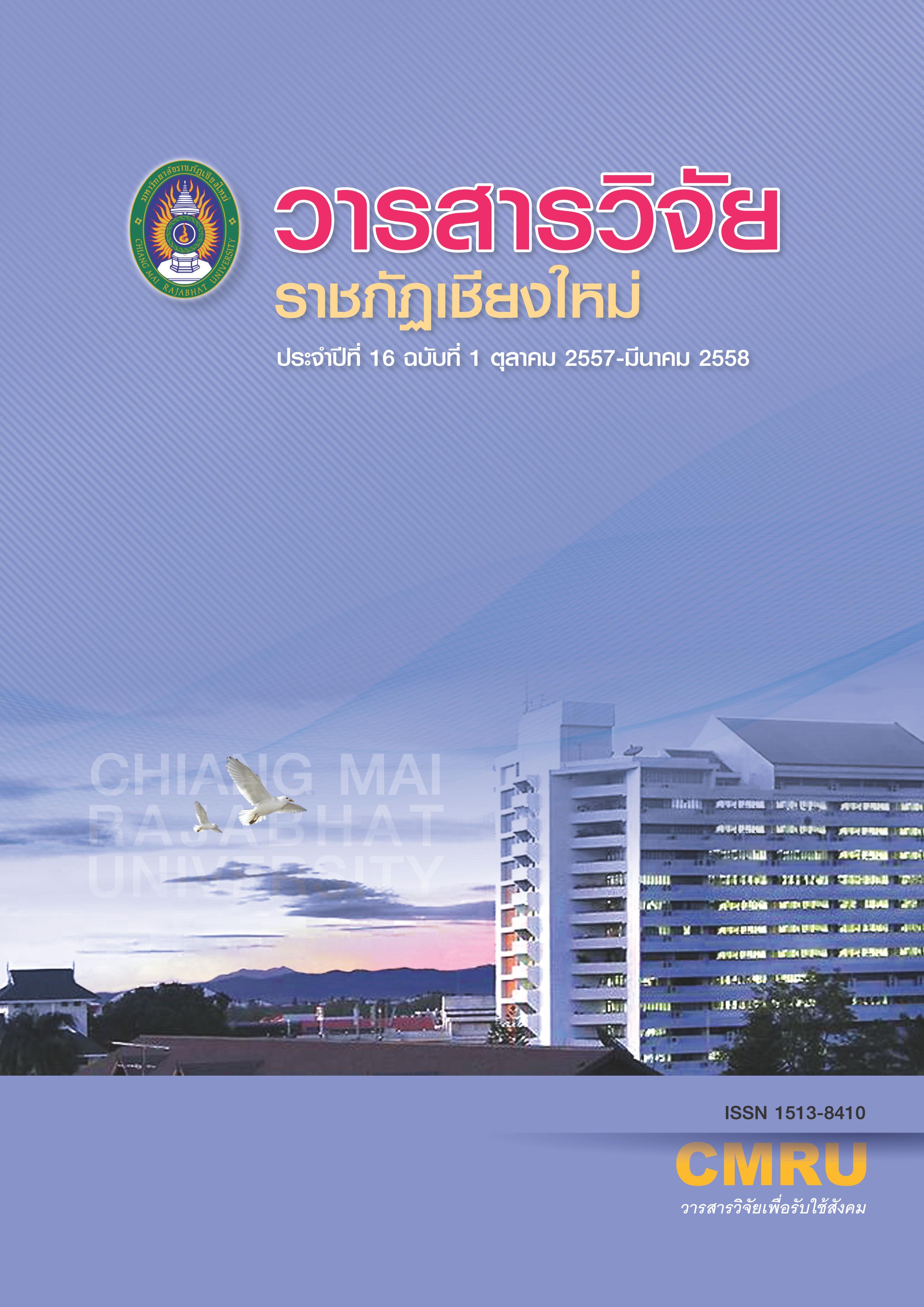Service Efficiency Development of Handicraft Retail Store In Chiang Mai Province
DOI:
https://doi.org/10.14456/rcmrj.2015.215101Keywords:
Service development, Handicraft retailer store, Souvenir, Thai tourist, Chiang MaiAbstract
The objectives of the study were to determine the factors that influence the decision of Thai tourists to choose Chiang Mai handicraft retailer in the tourist district and explore the problems in Chiang Mai handicraft retailer store. And create a distribution model for handicraft retailer store that attracts Thai tourists. This can increase revenue for the business throughout the year.
The study was a mixed methods research and there were combination between qualitative researches which use interviewing as a research instrument and quantitative research which survey research questionnaires were used to collect data. For qualitative, samples were drawn from 12 Chiang Mai handicraft retailer business samples, and 5 key informants from Government departments and agencies that have a role in supporting the business, by purposive sampling method. With quota sampling method, questionnaires were used for the quantitative data collected from the 804 Thai tourists.
The advanced statistical software is processed and analyzed data from the questionnaire. And factor analysis was used to explore the relationship of variables within the structure and group as interrelated variables. Finally, confirmatory factor analysis technique was used to create service business development model. The results showed that there were 7 groups, 1. Brand loyalty 2. Atmosphere multimedia creation 3. Ribbon 4. National local handicrafts 5. Merchandise display 6. Officer and personal, and 7. Design of Interior of factors were affected to Thai tourists in choosing Chiang Mai handicrafts retailer. With property management, the handicrafts retailer could more attractive for Thai tourists.
Downloads
References
กระทรวงการท่องเที่ยวและกีฬา. 2554. แผนพัฒนาการท่องเที่ยวแห่งชาติ (พ.ศ.2555-2559). กระทรวงการท่องเที่ยวและกีฬา.
เกยูร ใยบัวกลิ่น. 2553. ผลกระทบของการขยายตัวร้านค้าปลีกสมัยใหม่ที่มีผลต่อการดำเนินงานของร้านค้าปลีกแบบดั้งเดิม (โชว์ห่วย) : ความคิดเห็นของผู้ประกอบการร้านค้าปลีกแบบดั้งเดิม. วารสารวิจัย มหาวิทยาลัยเทคโนโลยีราชมงคลธัญบุรี. ปีที่ 13 ฉบับที่ 3 พฤษภาคม-สิงหาคม 2553: 101-113.
ฉลองศรี พิมลสมพงศ์ และเรณุมาศ มาอุ่น. 2553. การประเมินประสิทธิผลด้านการบริการนักท่องเที่ยวในแหล่งท่องเที่ยวเชิงวัฒนธรรมในภาคเหนือของประเทศไทย. วารสารเทคโนโลยีภาคใต้. ปีที่ 3 ฉบับที่ 2 กรกฎาคม – ธันวาคม 2553: 1-16.
ธานินทร์ ศิลป์จารุ. 2555. การวิจัย และวิเคราะห์ข้อมูลทางสถิติด้วย SPSS และ AMOS. พิมพ์ครั้งที่ 13. กรุงเทพมหานคร: ห้างหุ้นส่วนสามัญบิสซิเนสอาร์แอนด์ดี.
ปณิศา มีจินดา ศิริวรรณ เสรีรัตน์ และณักษ์ กุลิสร์. 2551. โครงการความจงรักภักดีของนักท่องเที่ยวชาวไทยและชาวต่างชาติต่อแหล่งท่องเที่ยวในจังหวัดเชียงใหม่ และจังหวัดภูเก็ต: รายงานวิจัยฉบับสมบูรณ์ (Destination Loyalty of Domestic and International Tourists toward Chiang Mai/Phuket). กรุงเทพฯ: สำนักงานกองทุนสนับสนุนการวิจัย.
ภาวิณี กาญจนาภา. 2554. การบริหารส่วนประสมการค้าปลีก และการจัดการเชิงกลยุทธ์การตลาดของร้านค้าปลีกแบบดั้งเดิม. วารสารบริหารธุรกิจ คณะพาณิชยศาสตร์และการบัญชี มหาวิทยาลัยธรรมศาสตร์. ปีที่ 24 ฉบับที่ 132 ตุลาคม-ธันวาคม 2554: 37-57.
สมาคมธุรกิจท่องเที่ยวจังหวัดเชียงใหม่. 2553. (ระบบออนไลน์). แหล่งข้อมูล: www.chiangmaitourism.org. (21 มกราคม 2554).
สำนักงานคณะกรรมการพัฒนาเศรษฐกิจและสังคมแห่งชาติ. 2549. แผนพัฒนาเศรษฐกิจและสังคมแห่งชาติ ฉบับที่ 10 (พ.ศ. 2550-2554). สำนักงานคณะกรรมการพัฒนาเศรษฐกิจและสังคมแห่งชาติ.
พาณิชย์จังหวัดเชียงใหม่. 2552. (ระบบออนไลน์). แหล่งข้อมูล: www.moc.go.th/opscenter/cm/. (17 กุมภาพันธ์ 2554).
ราณี อิสิชัยกุล และคณะ. 2545. การจัดการธุรกิจในแหล่งท่องเที่ยว.พิมพ์ครั้งที่ 2.นนทบุรี:สำนักพิมพ์ มหาวิทยาลัยสุโขทัยธรรมาธิราช.
เลิศพร ภาระสกุล. 2556. พฤติกรรมนักท่องเที่ยว. พิมพ์ครั้งที่ 2. กรุงเทพฯ: สำนักพิมพ์แห่งจุฬาลงกรณ์มหาวิทยาลัย.
Baker, J., Grewal, D. and Parasuraman, A. 1994. The influence of store environment on quality inference and store image. Journal of Academy of Marketing Science, 22: 328–339.
Cohen, E. 2000. Souvenir. In J. Jafari (Ed.). Encyclopedia of tourism. London. Routledge: 547–548
Holly, E., Bastow-Shoop., Dale, F., Zetocha and Gregory P. 1991. Visual Merchandising: A Guide for Small Retailers.
North Central Regional Center for Rural Development. Iowa State University of Science and Technology.
Kolter, P. 1974. Atmospherics as a marketing tool. Journal of Retailing, 49 (4): 48-64.
Kolter, P. 2003. Marketing Management. 11th ed. Singapore: Prentice-Hall.
Levy, M. and Weitz, B.A. 2012. Retailing Management. 8th ed. New York: McGraw-Hill/Irwin. 110-125.
Lovelock, C. and Wright, L. 2003. Services: marketing and management. Sao Paulo: Saraiva. 83.
Stephen, O. and Danielle, B. 2013. Store Sense, Reclaiming the four walls with sensory engagement. The Retail Acumen series. Deakin University Australia. 7.
Downloads
Published
How to Cite
Issue
Section
License
1. Articles, information, content, images, etc published in the “Community and Social Development Journal” are copyrighted by the Community and Social Development Journal, Chiang Mai Rajabhat University. In order to properly distribute the articles through print and electronic media, the authors still hold the copyright for the published articles under the Creative Commons Attribution (CC BY) license, which allows the re-distribution of the articles in other sources. References must be made to the articles in the journal. The authors are responsible for requesting permission to reproduce copyrighted content from other sources.
2. The content of the articles appearing in the journal is the direct responsibility of the article authors. The editorial board of the journal does not necessarily agree with or share any responsibility.














